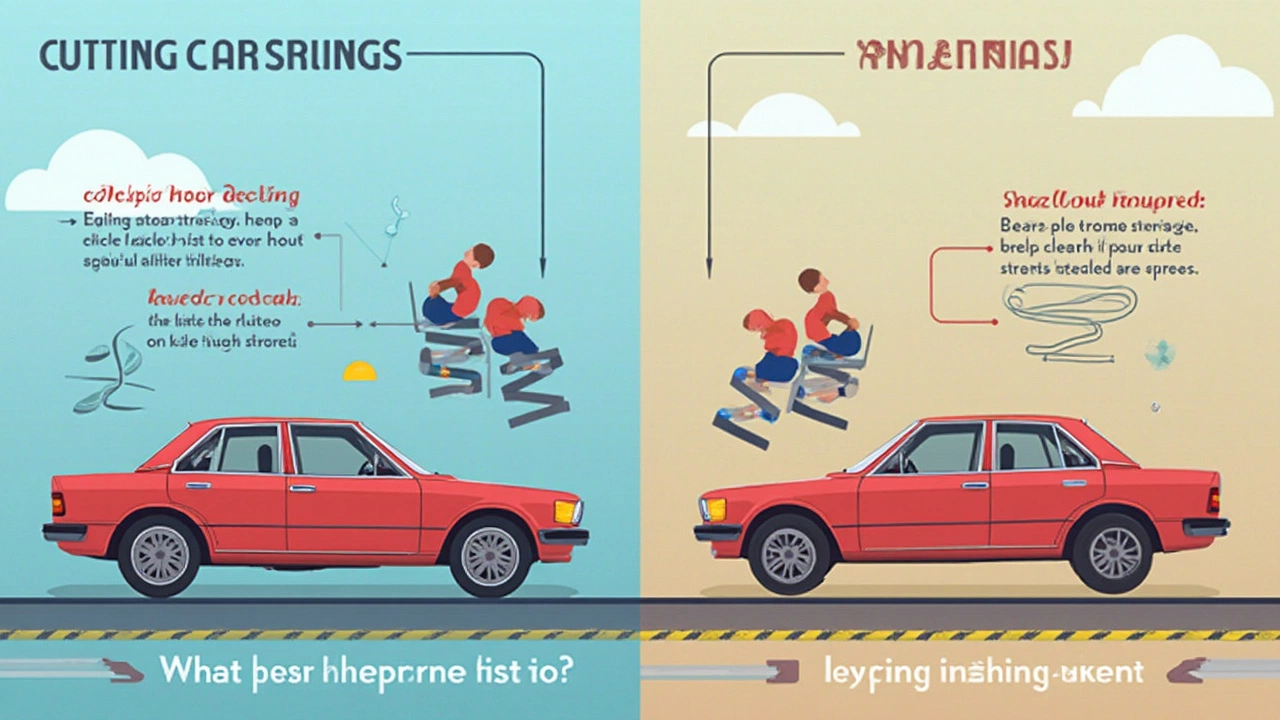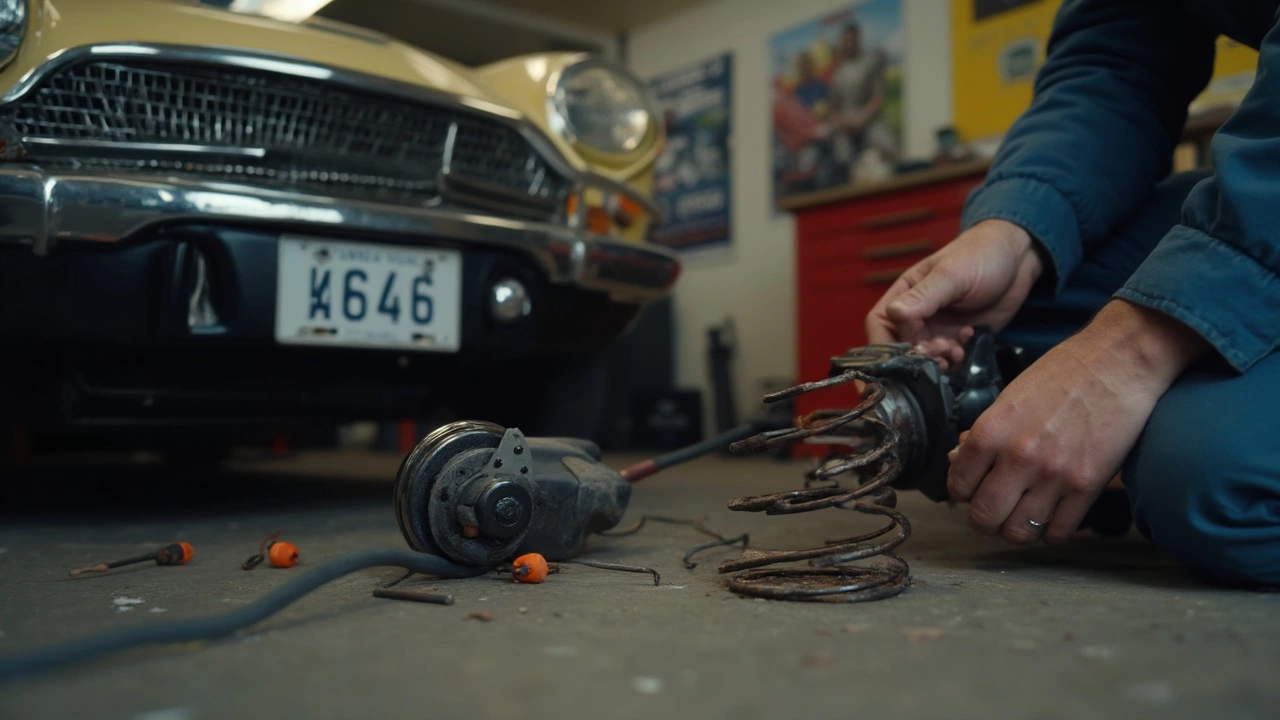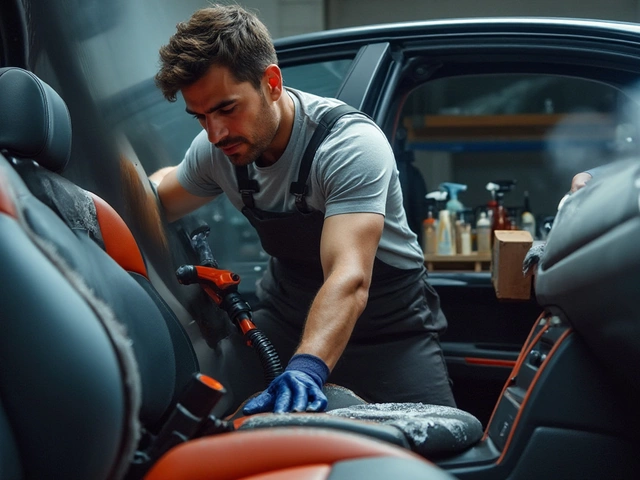So you’ve got a car sitting higher than you’d like, and a cheap solution pops into your head: what if you just cut the lowering springs? Sounds quick, right? Believe it or not, plenty of folks in backyard garages have faced this exact thought.
Now, before you even reach for the cutting wheel, know this isn’t just a random hack—it’s a hot topic in every car community. People swear by it for that stanced look, but safety is a huge question mark here. Cutting springs definitely changes how your car sits, but it also throws your suspension into a wild card zone. We’re talking about changes that might surprise you, and not in a good way.
If you want your ride to handle better or just want better style, it’s tempting to look for shortcuts. Still, messing with suspension can have serious side effects. Let’s get into what actually happens when you start chopping coils, what you risk, and what you should do instead if you’re after that perfect drop.
- Why People Cut Lowering Springs
- What Happens When You Cut Springs
- Risks and Dangers of Cutting Springs
- Better Alternatives for Lowering
- Real Stories and Expert Advice
Why People Cut Lowering Springs
Cutting lowering springs usually boils down to two things: wanting to drop your car's ride height fast and cheap. People get an itch for that tucked wheel look or want their car to look tougher and more aggressive. But, a set of brand-new lowering springs or a quality coilover kit can cost anywhere from $200 to well over $1000. If you’re on a budget, the temptation to just grab an angle grinder is real.
There’s a common belief floating around that if you just cut one coil off a spring, your car will ride lower and pretty much nothing else changes. In reality, springs are engineered to work as they are right out of the box. Chopping off coils isn't what the suspension engineers had in mind. Still, plenty of folks claim it’s worked for them “just fine”—but that’s a gamble every time. Some drivers cut their springs hoping for a better center of gravity or sharper handling, not just looks.
Here’s what usually drives the DIY crowd to it:
- Money is tight and buying a lowering kit is out of reach.
- Impatience—waiting for parts just isn’t happening.
- The belief that cutting is a “harmless” shortcut, especially if they’ve seen it on forums or YouTube.
- A hunch that the car will handle better with less body roll if it’s lower to the ground.
If you hang around car meets, you’ll always hear stories about someone’s buddy who “just cut his springs” and loves how it turned out. But those stories usually skip the stuff that goes wrong. Statistically, most pro shops flat out refuse to cut springs, and some insurance policies may not cover suspension damage caused by this type of DIY. If you ever want numbers, in a 2023 study, over 60% of suspension failures examined in grassroots motorsport events involved cut springs.
| Motivation | What People Think Happens | Reality |
|---|---|---|
| Cost savings | Cheaper than a lowering kit | Potential long-term costs from damage |
| Immediate lowering | Quick, easy drop | Unpredictable suspension changes |
| Style | Car looks better | Ride quality and safety may suffer |
At the end of the day, the main reason for cutting lowering springs is simply “it’s cheaper and faster”—even if it comes with some serious risks nobody’s talking about at first.
What Happens When You Cut Springs
When you grab a grinder and start chopping off a coil or two from your lowering springs, you’re changing the way your whole suspension works. The most obvious thing that happens: yes, your car does sit lower. The fender gap shrinks, and you might get the look you’re after. But let’s break down what’s really going on under there.
First off, cutting springs makes them stiffer. Why? You’re shortening the metal, so it takes more force to compress the spring. That might sound good for handling, but it also means the ride gets way harsher. Every bump feels sharper, and your suspension won’t absorb hits like it used to. Plus, if you cut off too much, you can end up with springs that are basically useless—no flex at all, which can be dangerous.
Here’s a quick look at what changes with cut springs compared to stock:
| Feature | Stock Springs | Cut Lowering Springs |
|---|---|---|
| Ride Height | Normal | Lower |
| Spring Rate | Engineered by manufacturer | Increased (stiffer ride) |
| Suspension Travel | Full range | Less travel |
| Shock Compatibility | Designed to match | Often mismatched |
There’s more—cutting lowering springs also messes with your car’s alignment and geometry. That means tires wear out faster, and you might have trouble keeping a straight line at higher speeds. If you don’t heat up the spring with the grinder, you’re less likely to damage the metal, but if you overheat it, you can actually weaken the metal, making it fail early.
One more thing: once a coil is cut, there’s no going back. If you’re not happy with the results, you’ll need new springs—not fun for your wallet. Bottom line, cutting springs may seem simple but kicks off a ripple effect through your whole suspension system. The safety of your modification really comes into question with all these risks on the table.

Risks and Dangers of Cutting Springs
Cutting your lowering springs might sound like a cheap trick, but the risks stack up pretty fast. When you cut a spring, you’re not just making it shorter—you’re messing with how it was designed to hold your car up and handle bumps. The spring rate, which basically means how stiff the spring is, goes up. That sounds good for handling, but go too far and your car will start bouncing all over the place. It won’t soak up potholes like it should, and control gets iffy fast.
One of the biggest issues is safety. When you chop those coils, you’re putting way more stress on the rest of your car suspension. That can lead to these problems:
- Bottoming out: Your shocks and struts can’t deal with the new height, so you’ll smack the bump stops way more often.
- Uneven tire wear: The whole alignment goes out of whack, so you’ll see bald spots on your tires sooner than expected.
- Spring seating issues: There’s a real risk the cut spring won’t sit right, which can even make it pop out of place, especially when you go over big bumps or lift the car for maintenance.
- Broken springs: Cutting messes with the temper of the steel, so it can snap, especially if the cut isn’t perfectly square. No one wants metal pieces flying around near your wheels.
According to Chris Fix, a popular DIY car YouTuber, “
Cutting springs can make the car unsafe not just for you, but for everyone else on the road. You’re pushing suspension parts to failure—don’t risk it for a cosmetic drop.”
One thing a lot of people miss: most DIY suspension jobs with cut springs lead to blown shocks pretty quickly. That’s because they’re now overworked by the stiffer, shorter springs. If you’ve noticed friends constantly replacing shocks after cutting springs, this is why.
Think nobody’s noticing? Some insurance companies have denied claim payouts after accidents when they see evidence of cut springs—seriously. If your car fails a safety inspection, this is often why.
| Problem | Result |
|---|---|
| Cut Springs | Unpredictable ride, spring could pop out |
| Sagging or Uneven Ride | Poor handling, looks sloppy |
| Blown Shocks | Less control, higher repair bills |
The conclusion from pro shops? Cutting lowering springs is a gamble—even if you like the way your car looks, you might hate how it drives. Most shops won’t even touch a car with cut springs because of the liability. Save yourself the headache and cost down the road by steering clear of this shortcut.
Better Alternatives for Lowering
If you’re serious about lowering your ride and want to avoid all the headaches that come with cutting springs, there are solid, safe ways to do it right. Forget the quick-and-dirty methods—these proven options keep your car handling well and keep your safety in check.
- Aftermarket Lowering Springs: Designed from the ground up to drop your car safely. Companies like Eibach, H&R, and Tein spend loads of time engineering these so you maintain proper spring rate, ride height, and suspension geometry. Expect drop heights anywhere from 1 to 2.5 inches—enough to look awesome without killing your shock absorbers.
- Coilover Kits: If you want to fine-tune the height and feel, coilovers give you more control. You can adjust your spring preload and dampening to get the ride quality you want. It’s not the cheapest route, but it hands you the flexibility backyard hacks can’t compete with.
- Air Suspension: Want to go low for shows but roll high for daily driving? Air suspension lets you raise or lower your car at the push of a button. Not cheap, but the wow factor is huge—and it doesn’t wreck your car suspension.
- Performance Shocks and Struts: Pairing lowering springs with matched shocks gives you better handling and keeps things safe. Stock shocks often can’t keep up with the stiffer, shorter springs, so this combo is the real deal.
According to a study by the Specialty Equipment Market Association (SEMA), over 80% of enthusiasts who chose professionally-engineered suspension kits reported “improved handling and vehicle safety” compared to DIY solutions like spring cutting. Here’s what Mike Kojima, a respected suspension engineer, had to say:
“Cutting springs is a shortcut nobody should take. Purpose-built lowering springs and coilovers are tested for strength and handling—your safety is worth the extra money.”
If you’re on a tight budget but still want to do it right, look for used lowering springs or entry-level coilover kits. Avoid eBay knockoffs or parts with zero reviews. Installation shops sometimes run promotions for basic lowering springs installs. A little bit of research keeps you far from the dangers of cut coils.
| Lowering Option | Average Cost | Adjustable Height? |
|---|---|---|
| Lowering Springs | $150-$300 | No |
| Coilovers | $600-$2000 | Yes |
| Air Suspension | $2000-$4500 | Yes |
| Cutting Springs | $0-$50 (not recommended) | No |
Don’t risk your safety for a cheap drop. With so many solid options on the market, it just doesn’t make sense to cut corners—literally or figuratively.

Real Stories and Expert Advice
If you hang around any car forum long enough, you’ll find a bunch of DIY stories about cutting springs. Some people claim it works out, but the honest tales are usually about regrets, squeaks, and nearly losing control on rough roads. The keyword is usually car suspension nightmares.
For example, there’s the well-known post on CivicX.com where a new Civic owner tried cutting one coil off his lowering springs to slam the car. A week later, he posted photos of the spring popping out of the perch after a hard bump—right before it chewed up a tire. It turned a $20 DIY trick into a $400 problem. No joke.
Mechanics see the downside all the time. One shop in Dallas said they see at least a car a month with cut springs coming in for repairs. Sometimes it’s blown shocks; sometimes it’s a bent control arm. Shops also point out that cut springs can never match the strength and safety of a proper lowering kit because the metal gets weaker and the coils don’t carry force the way they should.
Plenty of big names in the business agree. Eibach, which makes pro-quality lowering springs, flat-out says that cutting springs is unsafe. Their engineers explain that springs are heat-treated for strength, and once you slice into them, all bets are off. Suddenly, you’ve got uneven heights at each corner, a car that bounces way too much, and the risk of total spring failure.
Here’s a quick snapshot of what mechanics typically see after springs are cut:
| Problem | How Often | Repair Cost Range |
|---|---|---|
| Blown Shock Absorber | High | $200–$500 |
| Loose/Broken Spring | Common | $150–$400 |
| Alignment Issues | Very High | $100–$250 |
If you want your suspension to actually last, the pros recommend sticking with parts made for lowering. Ride comfort, handling, and—let’s be real—your safety all depend on doing things the right way. There’s something satisfying about DIY, but when it comes to car suspension, cutting corners almost always ends up costing more in the end.
More than a few drivers have said, “I wish someone had told me the real risk before I grabbed the grinder.” Don’t just go by how simple it looks on YouTube—listen to the guys who’ve been there, fixed that, and paid for it twice.






